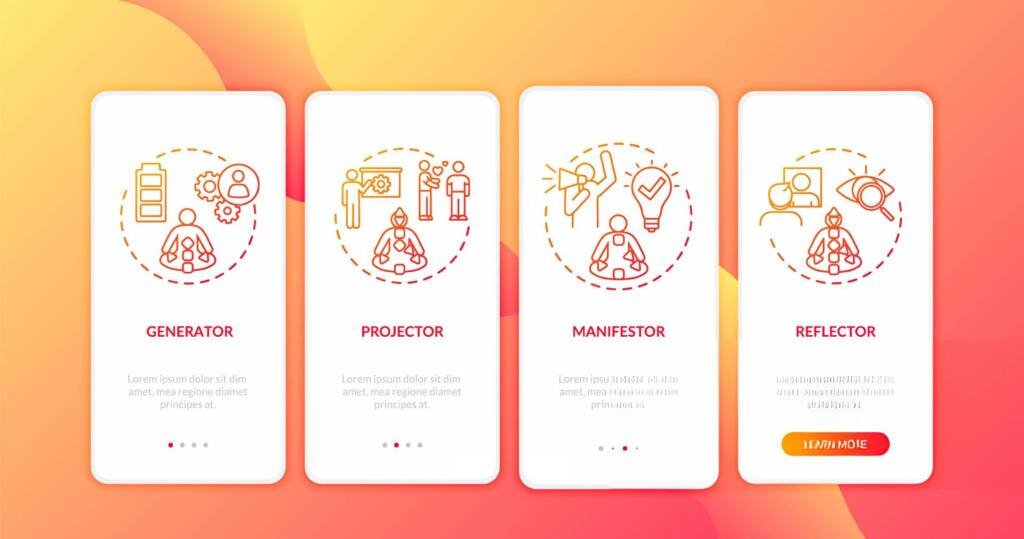Each child is a unique tapestry woven from countless personality, temperament, and potential threads. While many parents strive to understand their child’s individuality, they often find themselves grappling with traditional parenting methods that may not align with their child’s unique needs.
This is where Human Design—a system blending astrology, the I Ching, the Kabbalah, and quantum physics—comes into play. By understanding their child’s Human Design type, parents can tailor their approach, nurturing their child’s inherent strengths and aiding them in overcoming challenges.
Table of Contents
In this blog post, we’ll explore the five Human Design types found in children, offering insights and practical tips for parents looking to raise their children according to their unique designs. Whether you’re a veteran in Human Design or just beginning to explore this fascinating system, you’ll find valuable information and actionable advice to enhance your parenting approach.
What is Human Design?

Human Design is a modern synthesis of ancient wisdom and contemporary science. It claims that each person’s design is determined by the specific arrangement of celestial bodies at the moment of their birth, which influences their personality traits, behavior, and interactions. Human Design categorizes people into five distinct types, each with its unique characteristics and decision-making strategies. These types—manifestors, Generators, Manifesting Generators, Projectors, and Reflectors—serve as a roadmap to understanding oneself and others.
Why Use Human Design in Parenting?
Incorporating Human Design into parenting offers several benefits for both parents and children:
- Enhanced Understanding: By recognizing their child’s design, parents can better understand their behavior and needs, reducing frustration and increasing empathy.
- Effective Communication: Human Design provides insights into how different types perceive and process information, enabling parents to communicate more effectively with their children.
- Positive Discipline: Rather than adhering to one-size-fits-all discipline methods, parents can use their child’s design as a guide to promote positive behavior and personal growth.
- Support for Personal Growth: Acknowledging and nurturing a child’s unique design fosters self-acceptance and personal growth, setting the stage for a fulfilling life.
The Five Human Design Types in Children

1. Manifestor Children
Characteristics: Manifestor children are often independent, strong-willed, and natural initiators. They thrive when they have the freedom to explore their ideas and lead projects, usually displaying a knack for creativity and entrepreneurship from a young age.
Parenting Tips: To support Manifestor children, parents should provide them with space to lead and initiate. Rather than imposing rules and restrictions, it’s beneficial to involve them in decision-making processes. Encouraging their creativity and allowing them the freedom to explore their interests—whether it’s starting a new project or pursuing a creative hobby—will help them thrive.
Challenges: One familiar challenge parent face with Manifestor children is their tendency to act impulsively. They may not always think through the consequences of their actions, leading to conflicts with authority figures. To address this, parents can help them develop a sense of awareness by discussing potential outcomes before they take action. Establishing clear boundaries while allowing for flexibility will also help guide Manifestors in a positive direction.
2. Generator Children
Characteristics: Generator children are energetic, curious, and thrive on interaction. Their natural enthusiasm and desire to engage with the world around them make them incredible learners and companions. They often desire to respond to opportunities and experiences, making them highly adaptable and resourceful.
Parenting Tips: Keeping Generator children active and engaged is crucial to their happiness. Parents can do this by providing opportunities for exploration—be it through sports, arts, or outdoor activities. Additionally, allowing them to take the lead in choosing their activities encourages their natural ability to respond to the world around them. Listening to their preferences and interests fosters a sense of agency and fulfillment.
Challenges: A potential challenge for generator children is their tendency to become frustrated when their energy isn’t directed toward something meaningful. This frustration can manifest as tantrums or withdrawal. Parents can combat this by ensuring their children have plenty of opportunities to respond to their environment and engage in activities that excite them. Encouraging open communication about their feelings can help find constructive solutions when faced with frustration.
3. Manifesting Generator Children
Characteristics: Manifesting Generator children are a blend of the traits found in both Manifestors and Generators. They are often multi-talented, with a wide range of interests and abilities. Their adaptable nature allows them to switch between tasks seamlessly, but they may need to be sufficiently challenged to work on boredom.
Parenting Tips: Supporting Manifesting Generator children involves simultaneously allowing them to pursue multiple interests. Rather than forcing them to choose one path, parents can encourage their exploration of different hobbies and activities. Providing independent and collaborative play opportunities helps them thrive in their multifaceted nature. Lastly, acknowledging their need for variety and change fosters their sense of fulfillment.
Challenges: One familiar challenge parents face with Manifesting Generator children is their tendency to become scattered or lose focus. They may struggle to complete tasks when overwhelmed with too many choices or activities. To address this, parents can help them establish a routine that includes downtime for relaxation and reflection. Encouraging them to prioritize their commitments while honoring their need for variety will contribute to a balanced approach to their diverse interests.
4. Projector Children
Characteristics: Projector children are known for their ability to observe and guide others. They often display a deep understanding of the dynamics around them, making them natural leaders and facilitators. However, they require recognition and invitations to share their insights and talents.
Parenting Tips: Providing Projector children with opportunities to lead and guide their peers is essential for their development. This can be achieved by encouraging them to take on leadership roles in group activities or allowing them to express their opinions in family discussions. By acknowledging their contributions and providing them with the recognition they crave, parents empower their children to thrive in their unique roles within the family and society.
Challenges: One challenge parents may encounter with Projector children is their sensitivity to their environment and the energy of those around them. They may become easily overwhelmed or drained in chaotic or high-energy situations. Parents can create a stable and calming home environment to support them, incorporating routines that allow for downtime and reflection. Teaching Projectors coping strategies, such as mindfulness techniques, can also help them manage their sensitivity and recharge when needed.
5. Reflector Children
Characteristics: Reflector children are incredibly sensitive and intuitive, often acting as mirrors for the emotions and energies of their surroundings. They possess a deep understanding of the people around them and may take on the feelings of others, making them empathetic and compassionate.
Parenting Tips: Creating a stable and nurturing environment is crucial for Reflector children. Parents can achieve this by establishing consistent routines and rituals that provide a sense of security. Allowing them time to process their experiences and emotions without pressure encourages their natural ability to reflect. Engaging in activities that promote mindfulness, such as nature walks or art therapy, further supports their emotional well-being.
Challenges: Reflector children may face challenges related to their heightened sensitivity, such as feeling overwhelmed in busy or noisy environments. To address this, parents should teach them strategies for grounding and self-care, such as deep breathing exercises or journaling. Recognizing their unique perspective and allowing them the space to express their feelings fosters a sense of safety and acceptance.
Practical Applications of Human Design in Parenting

Daily Routines
Integrating Human Design principles into daily routines can significantly enhance the parenting experience. For example, allowing Manifestor children to have a say in their daily activities fosters their sense of autonomy. Generator children benefit from routines that include plenty of physical activity and opportunities to respond to their environment. Manifesting Generators thrive in dynamic routines that cater to their various interests, while Projector children require moments of quiet reflection amidst busyness. Reflector children benefit from flexible schedules that allow for downtime and processing.
Communication
Effective communication is critical to building strong relationships with children. Understanding each child’s Human Design allows parents to adapt their communication style accordingly. For instance, Manifestor children appreciate direct and clear communication, while Generator children thrive on responding to their environment. Manifesting Generators enjoy multitasking conversations, weaving between different topics, while Projector children excel in discussions that recognize their insights. Reflector children benefit from open-ended questions that encourage reflection and expression.
Discipline and Guidance
Discipline should not be a one-size-fits-all approach. Human Design offers insights into how to guide children based on their unique needs. For example, Manifestor children respond well to boundaries that allow for freedom of choice, while Generator children benefit from consequences that relate to their actions. Manifesting Generators thrive in environments that acknowledge their multifaceted nature, while Projector children require gentle guidance and recognition of their unique qualities. Reflector children benefit from discipline that takes into account their sensitive nature and emotional responses.
Benefits of Raising Children According to Their Human Design

Enhanced Relationships
Understanding and utilizing Human Design in parenting can significantly enhance the strength and quality of parent-child relationships. Human Design offers a unique framework that helps parents recognize their child’s distinct characteristics, strengths, and challenges.
Parents can effectively reduce frustration and enhance connection by tailoring their parenting approach to align with their child’s unique design. This thoughtful alignment allows for more effective communication and understanding, leading to a nurturing environment where children feel genuinely seen and understood.
As a result, this fosters a deeper emotional bond that promotes self-esteem and confidence in children and cultivates a sense of security and trust within the family dynamic, ultimately contributing to healthier and more fulfilling relationships.
Personal Growth for Children
Raising children according to their Human Design is an insightful approach that significantly supports their personal growth and self-awareness. Parents can create a nurturing environment that fosters their development by understanding and honoring each child’s unique design. When parents actively acknowledge and nurture their child’s specific traits and tendencies, they help the child recognize their strengths and challenges and cultivate a deeper understanding of themselves. This process encourages open communication and empathy within the parent-child relationship, allowing for meaningful discussions about feelings and experiences.
As children learn to accept themselves and appreciate their individuality, they build a solid foundation of self-acceptance that empowers them to evolve into confident individuals. This self-awareness enables them to thrive in alignment with their true selves, making choices that resonate with their authentic identity and enhancing their overall well-being. Ultimately, parenting with an awareness of Human Design equips children with the tools they need to navigate life’s challenges and opportunities with resilience and confidence.
Parental Satisfaction
Parents experience greater satisfaction and less stress when they intentionally align their parenting approach with their child’s unique design and personality traits. By taking the time to understand their child’s individual needs, preferences, and strengths, parents can effectively communicate, guide, and support them in a natural and authentic way. This deeper understanding helps reduce feelings of overwhelm and uncertainty that often come with parenting challenges.
As parents become more attuned to their child’s unique design, they can create an environment that encourages growth and development, leading to a more harmonious family dynamic. In this supportive atmosphere, parents can fully enjoy the joys and milestones of raising a child celebrated for their individuality, rather than feeling pressured to conform to conventional parenting norms. This approach strengthens the parent-child bond and fosters mutual respect and understanding within the family.
Conclusion
Incorporating Human Design into parenting offers a robust framework for nurturing children in alignment with their unique designs. By understanding each child’s Human Design type and adapting their parenting approach accordingly, parents can enhance their relationships, support their children’s personal growth, and experience greater satisfaction in their parenting journey.
Parents are encouraged to explore and apply Human Design principles in their parenting practices. By doing so, they can create a nurturing environment where every child feels valued, understood, and empowered to flourish in their own unique way.





